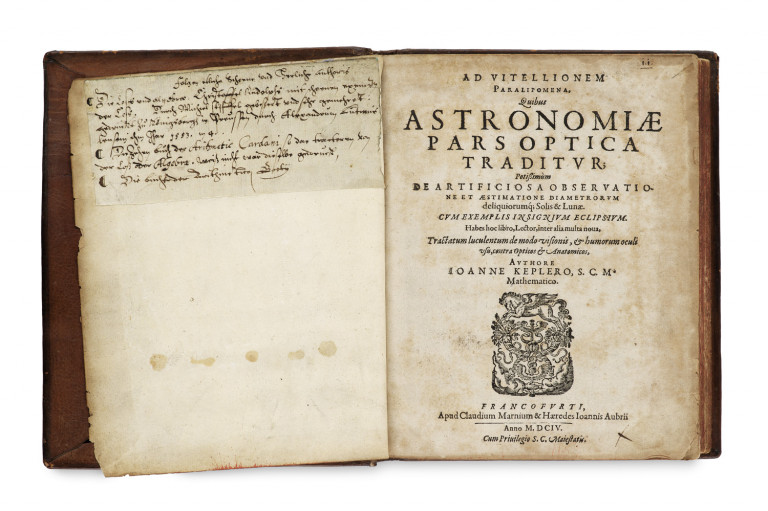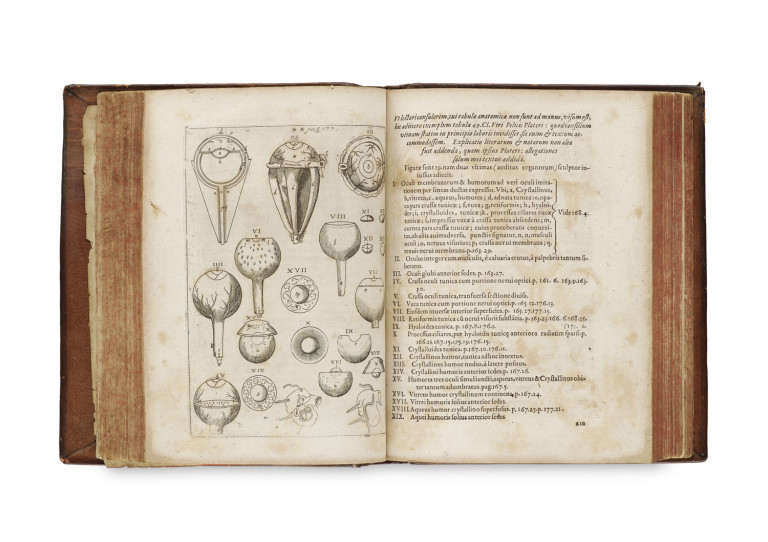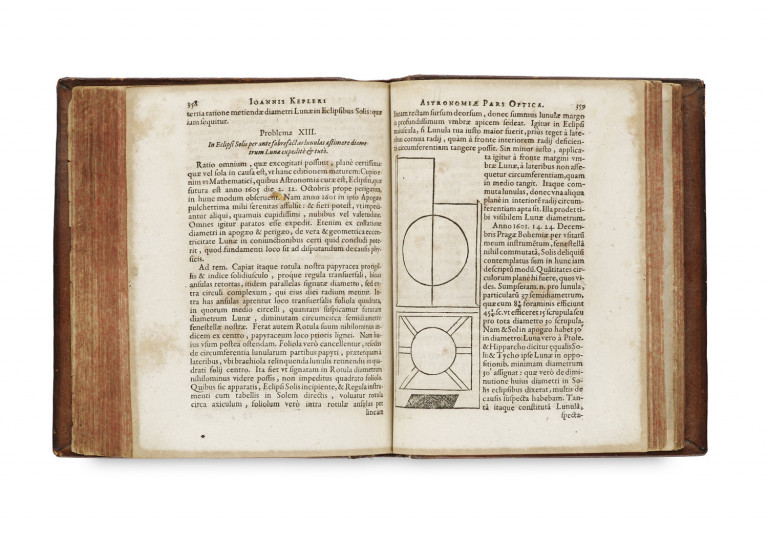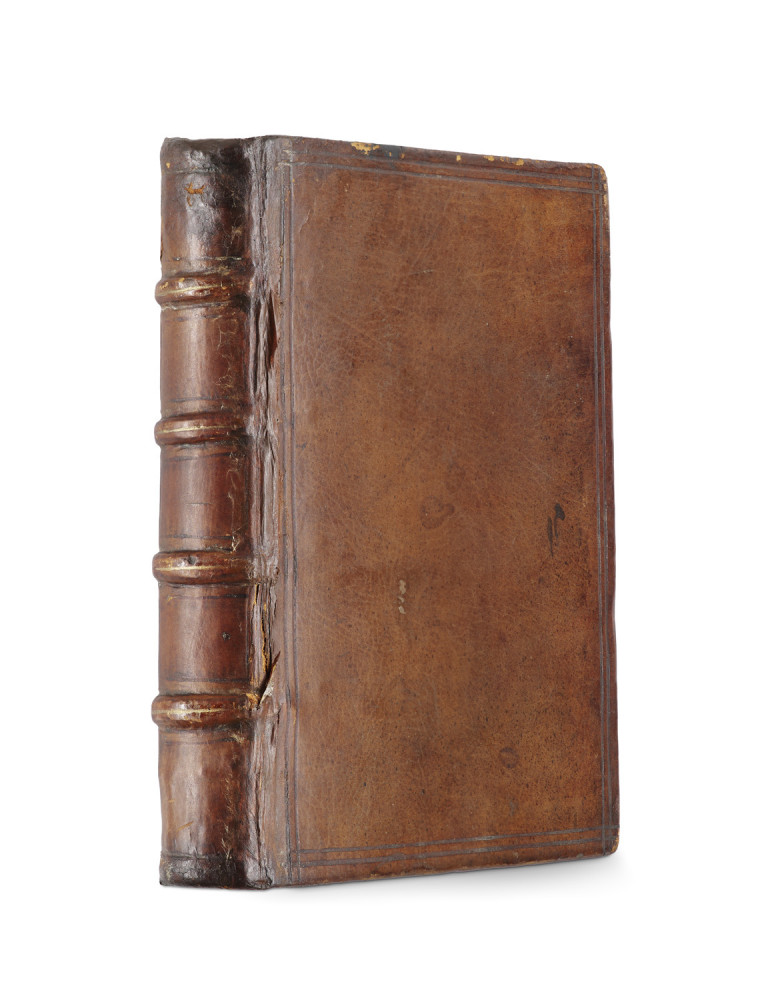Online Catalogue with all Lots / Auction 157
Wertvolle Bücher, Graphik, Historische Photographie
Friday, 24 October 2025 at 11:00 am Lose 1- 1105
Saturday, 25 October 2025 at 11:00 am Lose 1106-2003
Lot 1222 Johannes Kepler. Ad Vitellionem paralipomena, …
Ad Vitellionem paralipomena, quibus astronomiae pars optica traditur ... Titel mit Holzschnitt-Wappen, eine gravierte Tafel mit unnummeriertem Erläuterungsblatt (zwischen S. 176/177), zahlreiche Holzschnitt-Diagramme im Text, zwei gefaltete gedruckte Tabellen zwischen S. 424/425. Frankfurt, Marnium und Aubrius, 1604. 8 Bll., 449 S., 9 Bll. Geglätteter Kalbslederband d. Zt. mit blindgepr. Deckelfileten (etwas berieben u. leicht fleckig, Rücken etwas restauriert).
Astronomie
Naturwissenschaften – Erste Ausgabe von "Ad Vitellionem Paralipomena, Quibus Astronomiae Pars Optica Traditur" des deutschen Astronomen Johannes Kepler , seine Ergänzung zu Witelo, in der der optische Teil der Astronomie erläutert wird. - C. L. Parkinson, Breakthroughs, 1985, S. 61-62). - DSB VII, 289-312 (insbesondere 295-299). - Sotheran/Zeitlinger, 2, Nr. 10097. - Caspar 18. - Zinner 3993. - Das 1604 verfasste Werk "Astronomiae Pars Optica" untersucht die Eigenschaften des Lichts und wendet die Ideen der Reflexion und Brechung an, um astronomische Phänomene wie die Größe astronomischer Körper und die Natur von Sonnenfinsternissen zu erklären. Es untersucht auch die Funktionsweise des Lichts in Bezug auf Lochkameras und das menschliche Auge. In seiner Erklärung des Sehens erkannte Kepler als Erster die Bedeutung der Netzhaut und die Umkehrung von Bildern im Auge und erklärte als Erster, wie Brillen, die seit über drei Jahrhunderten verwendet werden, tatsächlich funktionieren (Brit. Acad., 2016). Keplers Verständnis von Licht und Sehen ermöglichte ihm später die Erfindung des Kepler-Teleskops im Jahr 1611. Durch den Ersatz des von Galileo verwendeten konkaven Okulars durch eine konvexe Linse konnte Kepler das Design erheblich verbessern. Dadurch wurde das erzeugte Bild zwar auf den Kopf gestellt, aber es ermöglichte ein viel größeres Sichtfeld. (Di Liscia, 2015). - "Keplers Optik ist ein unglaublich reichhaltiges Buch. Mit all seinen neuen Ideen und zahlreichen offenen Fragen bestimmte es die Agenda für einen Großteil der Lichtforschung im 17. Jahrhundert. Astronomen konnten in erster Linie seine theoretischen und instrumentellen Ideen aufgreifen, Naturphilosophen erforschten seine neue Sichtweise des Sehens, Mathematiker (darunter der junge Descartes) fanden einen Schatz an Rätseln der optischen Bildgebung und eine Einladung, Kegelschnitte fruchtbar zu machen, Ärzte entdeckten eine neue Grundlage für die Neubewertung von Augenleiden." (Rezension ISIS, 95, Nr. 2, 2004). - Gebräunt bzw. braunfleckig, erste Bll. mit kleinen Randläsuren, gelegentlich (meist im Außenrand etwas wasserrandig). - Besitzvermerk auf S. 1: "Johanes Brooke me possidet Nov. 28 1649." , Vorsatzblatt mit einmontiertem, wohl eigenhändigem Namenszug von "Lib. Rob: Hook:" und "patium: 8°". Möglicherweise aus einem anderen Werk aus der Bibliothek Rob. Hooks ausgeschnitten und unauffällig in dieses Werk einmontiert.
Natural Sciences – First edition. Title with woodcut device, an engraved plate with unnumbered explanatory leaf (between 176/177), numerous woodcut diagrams in the text, two folding printed tables between 424/425. Contemporary polished calf, rubbed, restored at spine, slightly water-stained, slightly browned and spotted as often, minor defects, browned as is usual for this book, still, a very good copy in a contemporary binding. - Written in 1604, 'Astronomiae Pars Optica' explores the properties of light, applying the ideas of reflection and refraction to explain astronomical phenomena, such as the size of astronomical bodies and the nature of eclipses. It also investigates the workings of light with regard to pinhole cameras and the human eye. In his explanation of vision, Kepler was the first to recognise the importance of the retina and the inversion of images within the eye, and the first to explain how eyeglasses, in use for over three centuries, actually worked, (Britannica Academic, 2016). Kepler's understanding of light and vision later allowed him to invent the Keplerian telescope in 1611, by replacing the concave eyepiece used by Galileo with a convex lens, Kepler was able to make considerable improvement to the design, although this inverted the image produced, it enabled a much wider field of view. (Di Liscia, 2015). - Ownership note on p. 1: "Johanes Brooke me possidet Nov. 28 1649." , Flyleaf with mounted, probably handwritten signature of "Lib. Rob: Hook:" and "patium: 8°". Possibly cut out from another work from Rob. Hook's library and inconspicuously mounted in this work.
Startprice: 10000 €
Estimate: 15000 €
Premium and taxation
This work is subject to under the regular margin scheme. There is a 24.95% buyer's premium on the hammer price and inside the EU 7% (Books, Paintings, Drawings and most Prints) and 19% (Photographs, Screen and Offsetprints, Autographs and Manuscripts) VAT on the final invoice amount.
Shipping
A pickup of this work is possible in our premises at Potsdamer Str. 16, 14163 Berlin by appointment. If you wish a shipment of the work, please contact us for a consultation and shipping calculation.
Terms and Conditions
You can view our terms and conditions here
Droit de Suite
On the sales proceeds of all original works of fine art and photography, whose authors have not yet died 70 years before the end of the sale, an additional 2% (subject to change) of the hammer prices from 400€ will be charged pro rata for the VG Bild-Kunst, which represents the copyrights of visual artists according to § 26 UrhG.
Submit a bid
I would like to participate in your auction by accepting the General Terms and Conditions of Jeschke van Vliet Auctions Berlin GmbH.



